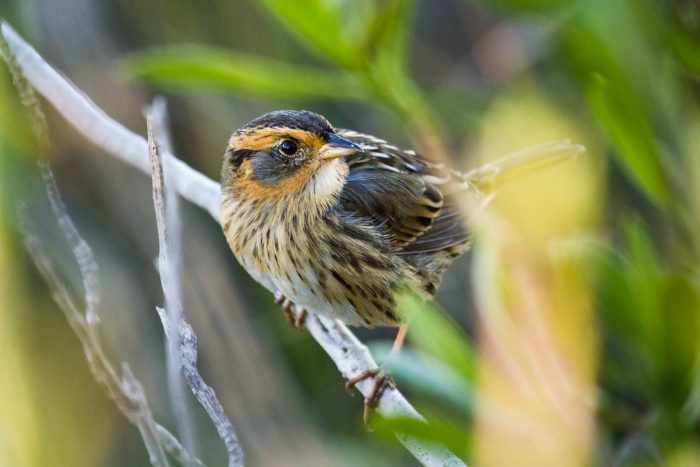Saltmarsh Sparrow
Ammospiza caudacuta
The saltmarsh sparrow is a small bird native to the tidal marshes of the Chesapeake Bay watershed.
This section shows one large critter image at a time. Use the thumbnails that follow to select a specific image to display here.

This gallery contains a grid of small thumbnails. Selecting a thumbnail will change the main image in the preceding section.
Appearance
Male and female sparrows have the same coloration and markings. The saltmarsh sparrow has an orange face with gray cheeks under its eyes, triangular dark patches by its ears and a black stripe on the top of its head stretching from its beak to its back. They have a pale chest with brown sides streaked with black. They have an elongated conical bill and a much shorter tail than other sparrows.
Feeding
Saltmarsh sparrows feed exclusively on food found in tidal salt marshes. They will catch bugs including grasshoppers, caterpillars and beetles to feed to young. During the winter months they will also feed on the seeds of marsh plants.
Predators
The main threat to the saltmarsh sparrow is flooding from high tides during nesting. Snakes, birds and marsh mammals are all predators of adult and immature sparrows.
Voice
The saltmarsh sparrow has a quiet song including a variety of high-pitched trills and clicks.
Reproduction and life cycle
Saltmarsh sparrows breed in the tidal salt marshes along the east coast from the Chesapeake Bay up to Maine. Males and females will have multiple mates and one brood will often have multiple male parents. Males are not involved in raising chicks or maintaining the nest. Females will lay between two to six eggs.
Did you know?
- The saltmarsh sparrow was originally called the sharp-tailed sparrow because of the shape of its tail feathers.
- Female sparrows will make up to 50 trips per day to feed baby sparrows.
- Due to significant disruptions to their habitat, the saltmarsh sparrow population is projected to drop at a rate of nine percent, leading to extinction within the next 30 years.
Sources and additional information
U.S. Fish & Wildlife Service: Saltmarsh Sparrow
Audubon Society: Saltmarsh Sparrow
Saltmarsh Sparrow Research Initiative: Learn about the saltmarsh sparrow
